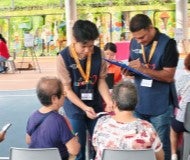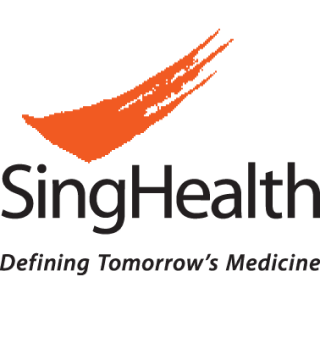Singapore General Hospital will NEVER ask you to transfer money over a call. If in doubt, call the 24/7 ScamShield helpline at 1799, or visit the ScamShield website at www.scamshield.gov.sg.
We’d love to hear from you! Rate the SGH website and share your feedback so we can enhance your online experience and serve you better. Click here to rate us
Burn Centre
The Burn Centre is the only specialised facility managing major burn injuries in Southeast Asia, committed to providing the best medical therapy to patients. The Burns Centre is run by a dedicated team of health care providers including doctors, nurses, physiotherapists, occupational therapists, nutritionists, medical social workers and other ancillary staff. Together, they look after burn patients from the point of injury to their post-hospital rehabilitative period.
The Burn Centre follows a strict admission criteria, and will only accept patients requiring specialised care including those that suffer from:
- more than15% burns in adults Total Burn Surface Area (TBSA) or more than 10% burns in children, and requiring fluid resuscitation
- burns involving special areas like the face, hands and perineum
- burns with an inhalational component / respiratory component
- burns resulting from electricity, chemicals or molten metals
- delayed or neglected burns with a deep-dermal or full-thickness component requiring surgery
Clinical Services
The SGH Burn Centre is a tertiary referral facility and will only accept burned patients requiring specialised care, and these are confined to patients with the following injuries :
- burns in adults > 15% TBSA or in children > 10% requiring fluid resuscitation
- burns involving special areas like the face, hands and perineum
- burns with an inhalational component / respiratory component
- burns resulting from electricity, chemicals or molten metals
- delayed or neglected burns with a deep-dermal or full-thickness component requiring surgery
- Strict admission criteria limit unneccesary admissions to minimize cross-contamination and to enable medical and nursing staff to concentrate on major burns patients and those patients who are critically-ill.
The Burn Centre admits patients through the following sources :
- the hospital’s Accident / Emergency Department following consultation and review by the
- on-call Plastic Surgery Resident and / or Registrar
- other hospital’s Accident / Emergency Department / ward (including private sector, semi-government restructured, and foreign) following telephone-consultation with the on-call Plastic Surgical Registrar and / or attending Plastic Surgeon; transport and medical escort of the patient is provided by source hospital
- direct from scene of injury following heli-casevac via the hospital’s Accident / Emergency Department.
Contact Information
Singapore General Hospital, Block 4 Level 3
Opening Hours
Monday to Friday: 8.00am to 6.00pm Saturday:
8.00am to 1.00pm
Sunday and Public Holiday: Closed
Tel: 6321 4430
Fax: 6321 3890
Facilities
The entire Centre is fully air-conditioned with the ventilation system comprising twenty air-changes an hour. This controlled environment which simulates an Operating Theatre environment is aimed at reducing levels of ambient airborne organisms thereby reducing cross-contamination of burns wounds with airborne organisms. A special viewing corridor outside the unit allows the patients in the isolation rooms to be in visual contact with their relatives without coming into direct physical contact.
The Centre is divided into two wings to facilitate cohort nursing. 6 beds are devoted to critically-ill patients, and 10 beds are set aside for patients requiring intermediate care in a high-dependency area. Separate areas are set aside for dressings change, physiotherapy and convalescence, and an area for paediatric patients.
A self-sufficient operating theatre enables all primary wound excision and skin grafting procedures to be performed within the Centre. Patients requiring secondary reconstructive procedures are not admitted to the Burn Centre and therefore secondary reconstructive procedures are generally not performed here. The utilization of this operating theatre situated within the Burn Centre has facilitated the ease of transfer of these major burns patients from their rooms to the theatre (the main hospital operating theatre is located some distance away on another floor). Ease of transfer of patients minimize the potential dangers of transport of the critically-ill, the main ones being airway disconnection and discontinuity in monitoring. In addition, theatre scrub personnel dedicated to burns surgery has also greatly expedited the performance of the surgical procedures.
A cell culture laboratory within the Burn Centre dedicated to the culture and preparation of cultured epithelial autografts provides laboratory support for our skin culture project.
Resources
The use of Moist Exposed Burn Therapy in the treatment of burns wounds
This clinical trial investigates the efficacy of Moist Exposed Burn Ointment in the management of mixed-thickness burns wounds as compared to conventional management with silver sulphadiazine. Outcome indicators include time for wound healing, resultant scar quality and use of analgesia. (NMRC/0125/1995).
Growth hormone efficacy in severely-burned patients
The use of recombinant growth hormone has been investigated by several centres in the United States for patients with severe thermal injuries. Favourable results have been reported in terms of acceleration of donor site healing time and reduction of hospital stay. Our clinical trial will investigate the impact of recombinant growth hormone on donor site and grafted site healing, and morbidity in patients with major thermal injury.
Integra artificial skin for coverage of large burn areas
Limited donor sites remain a major problem with patients sustaining large area burns. Integra artificial skin acts as a minimally-immunogenic biological dressing following excision of burn wounds and allows the use of thin split skin autografts which in turn means that donor sites can be re-cropped more frequently. Research efforts are also aimed at combining Integra with cultured epithelial autograft.
Skin Culture Research
Together with the Department of Clinical Research of SGH, we have been actively involved in research into expediting the growth and take of cultured epithelial cells including use of fibrin glue and other techniques. Research is also being carried out in the use of lyophilised amniotic membrane.
Skin Bank
The Singapore General Hospital's (SGH) Skin Bank/Skin Culture Laboratory was set up in 1991 to meet the skin graft needs for the treatment of patients with severe burns.
Recent News

The Burns Centre at Singapore General Hospital
New Burns Protocol Speeds Up Skin Recovery with Fewer Complications and Shortens Hospital Stay for Burns Patients, SGH Latest Study Shows
Stay Healthy With
Outram Road, Singapore 169608
© 2025 SingHealth Group. All Rights Reserved.



















